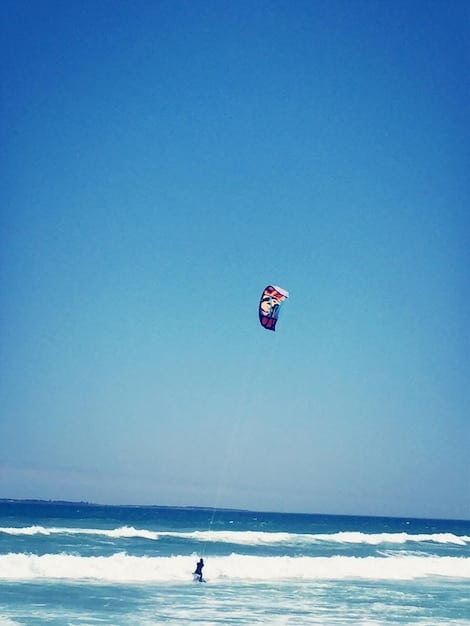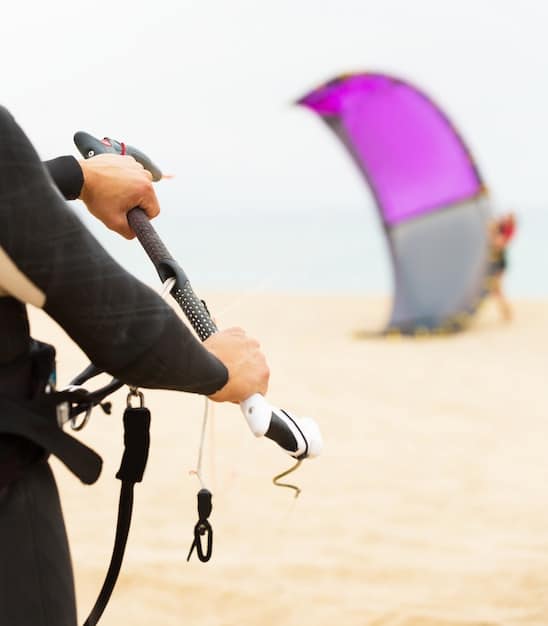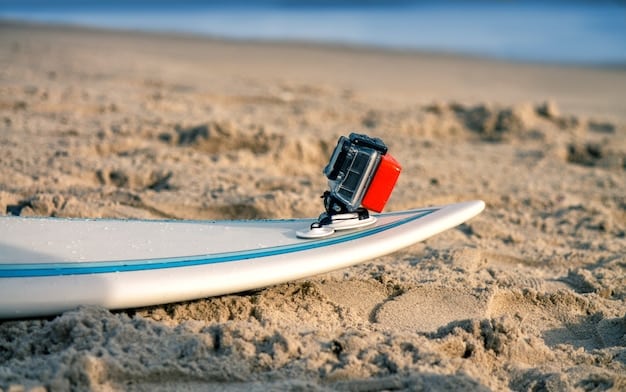Kitesurfing Safety 2025: Essential Emergency Procedures

Kitesurfing safety in 2025 emphasizes updated emergency procedures, including enhanced quick-release systems, improved communication protocols, and comprehensive self-rescue techniques, ensuring kitesurfers are well-prepared for unforeseen situations on the water.
Kitesurfing is an exhilarating sport, but it’s crucial to stay updated on safety measures. In 2025, new emergency procedures are set to become standard practice, and every kitesurfer should be aware of them. This article dives into the most important aspects of kitesurfing safety: new emergency procedures every kitesurfer should know in 2025, ensuring you’re prepared for any situation.
Understanding the Updated Quick-Release Systems
Quick-release systems are a critical component of kitesurfing safety. These systems allow riders to quickly detach themselves from the kite in emergency situations. The updates for 2025 involve improvements in the reliability and ease of use of these systems.
Enhanced QR Mechanisms
The new quick-release systems feature streamlined designs that reduce the risk of accidental releases while making intentional releases easier even under tension. They are also more resistant to corrosion and wear, ensuring long-term reliability.
Testing Your QR Regularly
It’s essential to regularly inspect and test your quick-release system. Before each session, ensure that the mechanism is functioning correctly and that you can release it quickly and easily.
- Check for wear and tear: Inspect all parts of the QR system for signs of damage or corrosion.
- Practice releasing: Regularly practice releasing the QR system in a safe environment to build muscle memory.
- Keep it clean: Rinse the QR system with fresh water after each session to prevent salt buildup and corrosion.
These updated quick-release systems provide an added layer of safety for kitesurfers, making it simpler to manage emergencies and reduce the risk of injury. Regular maintenance and practice are key to maximizing their effectiveness.

Mastering Self-Rescue Techniques in 2025
Self-rescue techniques are crucial for any kitesurfer. These techniques enable you to get back to shore safely if you encounter problems out on the water. The updated procedures focus on simplified methods and improved gear.
The Importance of the Body Drag
Body dragging is a fundamental skill every kitesurfer needs to master. It involves using the kite to pull you through the water towards a safe location. The new techniques emphasize maintaining control and using the kite efficiently.
Re-launching the Kite in the Water
Being able to re-launch your kite from the water is another essential skill. The updated methods include tips for minimizing drag and using the wind to your advantage.
- Assess the situation: Before attempting to re-launch, check for any hazards and ensure you have enough space.
- Position the kite: Position the kite at the edge of the wind window to catch the wind and lift it out of the water.
- Use the lines: Use the kite lines to steer the kite and generate power to pull yourself up.
Mastering these self-rescue skills will significantly enhance your safety on the water, allowing you to handle a variety of challenging situations with confidence. Regular practice and familiarity with your gear are vital.
Understanding New Communication Protocols
Effective communication is essential for safety, especially in crowded kitesurfing spots. The updated protocols introduce standardized signals and communication devices to help kitesurfers communicate more effectively with each other and with rescue services.
Standardized Hand Signals
Using hand signals can help you communicate with other kitesurfers and beachgoers. New signals are being introduced to indicate specific problems or needs.
The Role of Radios and Waterproof Devices
Waterproof radios and communication devices are becoming more common among kitesurfers. These devices allow you to call for help or communicate with others in your group. Ensure your device is fully charged and easily accessible.
- Learn the signals: Familiarize yourself with the standardized hand signals and practice them regularly.
- Carry a radio: Invest in a waterproof radio and learn how to use it to communicate in an emergency.
- Test your equipment: Regularly test your communication devices to ensure they are functioning correctly.
By utilizing these updated communication protocols, kitesurfers can enhance their safety and ensure that help is available when needed. Clear and effective communication can make a significant difference in emergency situations.

The Importance of Pre-Kitesurfing Checks
Before heading out on the water, conducting thorough pre-kitesurfing checks is crucial for ensuring a safe and enjoyable experience. These checks involve assessing weather conditions, inspecting your equipment, and informing someone of your plans.
Assessing Weather Conditions
Understanding the wind speed, direction, and weather forecast is essential. Check for any potential hazards, such as storms or strong currents, and be prepared to adjust your plans accordingly.
Equipment Inspection Checklist
Inspect your kite, lines, harness, and board for any signs of damage or wear. Ensure that all components are in good working condition and properly adjusted.
- Check wind conditions: Monitor wind speed and direction, and be aware of any changes in the weather forecast.
- Inspect your kite: Look for any tears, holes, or damage to the kite canopy and struts.
- Inform someone: Let someone know your kitesurfing plans, including your location and estimated return time.
By conducting these pre-kitesurfing checks, you can identify and address potential issues before they become problems on the water, significantly enhancing your safety and peace of mind.
Understanding Local Regulations and Safety Zones
Each kitesurfing location has its own set of regulations and designated safety zones. Understanding and adhering to these rules is essential for ensuring your safety and the safety of others.
Researching Local Rules
Before kitesurfing in a new location, take the time to research the local regulations and any specific hazards. Consult with local kitesurfing schools or experienced riders for valuable insights.
Respecting Safety Zones
Safety zones are designated areas where kitesurfing is either prohibited or restricted. These zones are often established to protect swimmers, boaters, or sensitive environmental areas. Adhere to these zones to avoid accidents and fines.
- Consult local resources: Contact local kitesurfing schools or riders for information on regulations and safety zones.
- Observe signage: Pay attention to any signs or markers indicating restricted areas or potential hazards.
- Respect other users: Be mindful of swimmers, boaters, and other water users and maintain a safe distance.
By respecting local regulations and safety zones, you can contribute to a safe and enjoyable environment for all kitesurfers and water users, promoting responsible and sustainable kitesurfing practices.
The Role of Kitesurfing Schools and Certifications
Taking lessons from a certified kitesurfing school is the best way to learn the sport safely and effectively. These schools provide instruction on essential skills, safety procedures, and local regulations.
Benefits of Professional Instruction
Professional instructors can provide personalized guidance, identify potential safety hazards, and help you develop the skills and knowledge necessary to kitesurf safely and confidently.
Understanding Certification Levels
Kitesurfing certifications demonstrate that you have met certain standards of competence and safety. Obtaining a certification can help you rent equipment, access certain kitesurfing spots, and demonstrate your commitment to safe practices.
- Find a certified school: Look for kitesurfing schools that are certified by recognized organizations such as the IKO or VDWS.
- Progressive learning: Follow a structured progression of lessons to build your skills and knowledge gradually.
- Understand your limits: Know your limits and avoid attempting advanced techniques or challenging conditions until you are ready.
By investing in professional instruction and obtaining relevant certifications, you can significantly enhance your safety and enjoyment of kitesurfing, developing a solid foundation of skills and knowledge that will serve you well for years to come.
| Key Point | Brief Description |
|---|---|
| 🚨 Quick Release Systems | Updated systems enhance safety by allowing quick kite detachment in emergencies. |
| 🆘 Self-Rescue Techniques | Essential skills like body dragging and kite re-launching help you return to shore safely. |
| 🗣️ Communication Protocols | Standardized hand signals and waterproof radios improve communication on the water. |
| ✔️ Pre-Kitesurfing Checks | Weather assessment, equipment inspection, and informing someone of your plans are vital. |
Frequently Asked Questions
▼
The key updates include more reliable mechanisms, easier releases under tension, improved corrosion resistance, and designs reducing accidental releases, ensuring better kitesurfing safety.
▼
Mastering self-rescue techniques is crucial as it enables kitesurfers to return to shore safely when facing issues like equipment failure or adverse weather, promoting greater independence and safety.
▼
Standardized communication protocols, like hand signals and waterproof radios, enhance safety by facilitating clear communication between kitesurfers and rescue services during emergencies.
▼
Weather checks are critical in pre-kitesurfing safety routines because they help assess wind conditions and potential hazards, enabling kitesurfers to avoid dangerous situations and ensure a safer outing.
▼
Understanding local regulations and safety zones is necessary to protect both kitesurfers and other water users by preventing accidents and ensuring compliance with established rules and guidelines.
Conclusion
Staying informed and prepared is essential for every kitesurfer. By understanding and implementing these updated emergency procedures, you can significantly enhance your safety on the water and enjoy the sport with greater confidence in 2025.





